-
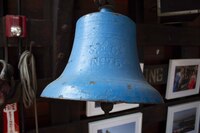 Fog Bell (fr)
Fog Bell (fr) Une cloche antibrouillard est utilisée pour avertir les navires des dangers dans des conditions de faible visibilité en indiquant la position du navire.
-
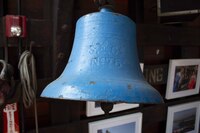 Fog Bell (sp)
Fog Bell (sp) Una campana de niebla se utiliza para advertir a los barcos de peligros en condiciones de baja visibilidad indicando la posición del barco.
-
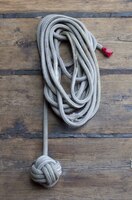 Ligne d'attrape (fr)
Ligne d'attrape (fr) Le nœud de poing d'un singe est un gros nœud qui ressemble à un poing ou à une patte et qui est noué au bout d'une corde pour ajouter du poids. On l'appelle également patte de singe. Les marins utilisaient le nœud pour ajouter du poids à l'extrémité d'une ligne d'attrape, ce qui la rendait plus facile à lancer d'un navire au rivage.
-
 Mark Twain (fr)
Mark Twain (fr) "Mark Twain" est un terme nautique utilisé par le chef de bord d'un bateau à vapeur pour indiquer que l'eau était suffisamment profonde pour voyager en toute sécurité. Le terme vient des marques faites sur une ligne utilisée pour mesurer la profondeur de l'eau.
-
 Mark Twain (sp)
Mark Twain (sp) "Mark Twain" es un término náutico utilizado por el líder de un barco de vapor para indicar que el agua era lo suficientemente profunda como para viajar con seguridad. El término proviene de las marcas hechas en una línea utilizada para medir la profundidad del agua.
-
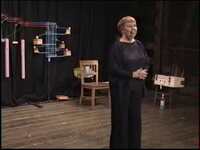 Betty Bryant on the Waterfront Museum Barge, Lehigh Valley no. 79
Betty Bryant on the Waterfront Museum Barge, Lehigh Valley no. 79 Betty Bryant shares her memories of growing up in a showboat family.
-
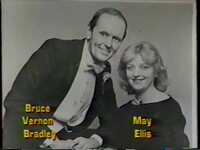 The Driftwood Floating Theatre Showboat: The End of A 150 Year Tradition?
The Driftwood Floating Theatre Showboat: The End of A 150 Year Tradition? Documentary about the Driftwood Theatre showboat barge
-
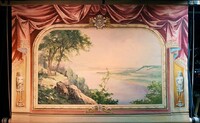 Olio Curtain
Olio Curtain This olio curtain is a replica of one chosen by the Waterfront Museum from the collection of University Art Museum at the University of Minnesota, Minneapolis. We commissioned scenic painters to recreate the design for Showboats ‘Round the Bend, an exhibit produced in collaboration with the Theatre Museum.
David Sharps searched University Art Museum at the University of Minneapolis, Minnesota collection website for rivers, lakes, streams, tugboats, barges, whatnot and this was one of the choices, which reminded him of the Palisades.
It served as the model for this replica for an exhibit on showboats that was a partnership between The Theatre Museum and The Waterfront Museum. Helen Guditis and David Sharps with Mary Habstritt as curator, filled the barge with panels that explained the showboat era both in New York and in general. The exhibition on showboats was donated to the Maritime Industry Museum at Fort Schuyler, SUNY Maritime in the Bronx.
-
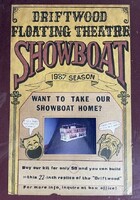 Driftwood Theatre Showboat Poster
Driftwood Theatre Showboat Poster This poster offers the paper model of the Driftwood Theatre showboat for sale.
-
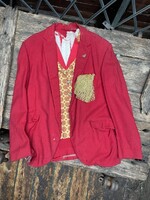 Concessionaire's Jacket
Concessionaire's Jacket Jacket worn by Captain Tom, while selling candy and popcorn during intermission.
David Sharps remembers, “He was a magician, but as the showboat captain he often did the candy sales….It was a lot of entertainment and a lot of hype to get people to buy popcorn and support the boat.”
-
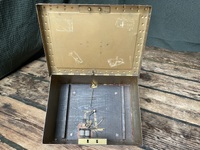 Cash Box
Cash Box This cash box was used for ticket sales at the Driftwood Showboat. It has a false bottom secured by a chain that it takes two people to release, making a more secure place to store the large bills,
There is also a battery powered alarm that sounded when the false bottom was removed.
-
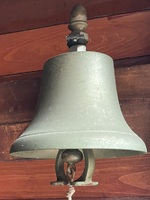 Lobby Bell
Lobby Bell The lobby bell from The Driftwood Showboat. This bell would sound when the boat was open for the general public to come aboard.
-
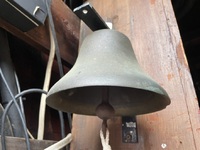 Curtain Bell
Curtain Bell Captain Tom MacGuire rang this bell to get the audience’s attention at the start of each show on the Driftwood Showboat.
David Sharps recalls:
I asked Captain Tom, “How many times would you ring it?”
“Oh, that’s a good bell–once!”
-
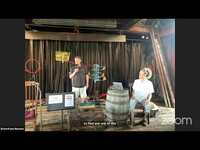 Barge Family Reunion Celebration
Barge Family Reunion Celebration
-
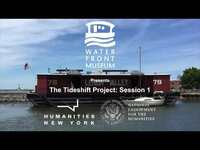 Break Bulk Longshoremen Oral Histories
Break Bulk Longshoremen Oral Histories
-
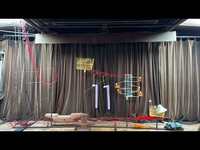 Audio-Kinetic Sculpture by George Rhoads
Audio-Kinetic Sculpture by George Rhoads
-
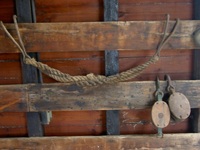 Barrel Hooks or Barrel Yokes
Barrel Hooks or Barrel Yokes
-
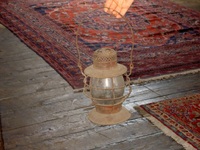 Railroad Lantern
Railroad Lantern
-
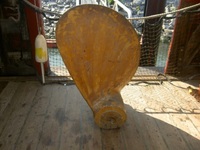 Screw Propeller foundry pattern (partial)
Screw Propeller foundry pattern (partial) Foundry patterns like this were carved from plans by pattern-makers. The finished pattern was placed embeeded halfway into fine sand in a frame, then another frame was set atop the first and more fine sand was packed around the top half of the pattern to fill the frame until the sand held its shape when the frames were pulled apart. With the frames separated, the pattern was removed, leaving a cavity in the sand. The frames were put together again, a hole was dug through the sand in the top frame and molten metal was poured through the hole to fill the cavity producing a new object in the shape of the pattern.
-
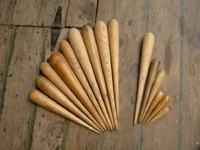 Fids
Fids Conical pins or spikes used to separate ropes or braids of rope for splicing and other knot work.
-
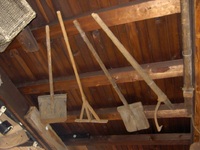 Grain Shovel, Rake, and Short-Handled Peavey
Grain Shovel, Rake, and Short-Handled Peavey
-
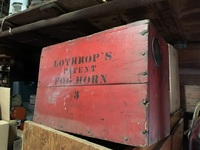 Fog Horn
Fog Horn
-
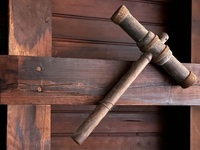 Caulking Mallet
Caulking Mallet
-
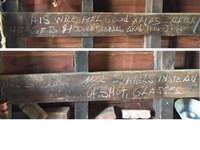 Longshoremen Graffiti
Longshoremen Graffiti
-
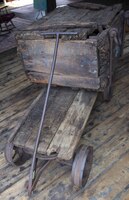 Railroad Cart
Railroad Cart
 Fog Bell (fr) Une cloche antibrouillard est utilisée pour avertir les navires des dangers dans des conditions de faible visibilité en indiquant la position du navire.
Fog Bell (fr) Une cloche antibrouillard est utilisée pour avertir les navires des dangers dans des conditions de faible visibilité en indiquant la position du navire. Fog Bell (sp) Una campana de niebla se utiliza para advertir a los barcos de peligros en condiciones de baja visibilidad indicando la posición del barco.
Fog Bell (sp) Una campana de niebla se utiliza para advertir a los barcos de peligros en condiciones de baja visibilidad indicando la posición del barco. Ligne d'attrape (fr) Le nœud de poing d'un singe est un gros nœud qui ressemble à un poing ou à une patte et qui est noué au bout d'une corde pour ajouter du poids. On l'appelle également patte de singe. Les marins utilisaient le nœud pour ajouter du poids à l'extrémité d'une ligne d'attrape, ce qui la rendait plus facile à lancer d'un navire au rivage.
Ligne d'attrape (fr) Le nœud de poing d'un singe est un gros nœud qui ressemble à un poing ou à une patte et qui est noué au bout d'une corde pour ajouter du poids. On l'appelle également patte de singe. Les marins utilisaient le nœud pour ajouter du poids à l'extrémité d'une ligne d'attrape, ce qui la rendait plus facile à lancer d'un navire au rivage. Mark Twain (fr) "Mark Twain" est un terme nautique utilisé par le chef de bord d'un bateau à vapeur pour indiquer que l'eau était suffisamment profonde pour voyager en toute sécurité. Le terme vient des marques faites sur une ligne utilisée pour mesurer la profondeur de l'eau.
Mark Twain (fr) "Mark Twain" est un terme nautique utilisé par le chef de bord d'un bateau à vapeur pour indiquer que l'eau était suffisamment profonde pour voyager en toute sécurité. Le terme vient des marques faites sur une ligne utilisée pour mesurer la profondeur de l'eau. Mark Twain (sp) "Mark Twain" es un término náutico utilizado por el líder de un barco de vapor para indicar que el agua era lo suficientemente profunda como para viajar con seguridad. El término proviene de las marcas hechas en una línea utilizada para medir la profundidad del agua.
Mark Twain (sp) "Mark Twain" es un término náutico utilizado por el líder de un barco de vapor para indicar que el agua era lo suficientemente profunda como para viajar con seguridad. El término proviene de las marcas hechas en una línea utilizada para medir la profundidad del agua. Betty Bryant on the Waterfront Museum Barge, Lehigh Valley no. 79 Betty Bryant shares her memories of growing up in a showboat family.
Betty Bryant on the Waterfront Museum Barge, Lehigh Valley no. 79 Betty Bryant shares her memories of growing up in a showboat family. The Driftwood Floating Theatre Showboat: The End of A 150 Year Tradition? Documentary about the Driftwood Theatre showboat barge
The Driftwood Floating Theatre Showboat: The End of A 150 Year Tradition? Documentary about the Driftwood Theatre showboat barge Olio Curtain This olio curtain is a replica of one chosen by the Waterfront Museum from the collection of University Art Museum at the University of Minnesota, Minneapolis. We commissioned scenic painters to recreate the design for Showboats ‘Round the Bend, an exhibit produced in collaboration with the Theatre Museum. David Sharps searched University Art Museum at the University of Minneapolis, Minnesota collection website for rivers, lakes, streams, tugboats, barges, whatnot and this was one of the choices, which reminded him of the Palisades. It served as the model for this replica for an exhibit on showboats that was a partnership between The Theatre Museum and The Waterfront Museum. Helen Guditis and David Sharps with Mary Habstritt as curator, filled the barge with panels that explained the showboat era both in New York and in general. The exhibition on showboats was donated to the Maritime Industry Museum at Fort Schuyler, SUNY Maritime in the Bronx.
Olio Curtain This olio curtain is a replica of one chosen by the Waterfront Museum from the collection of University Art Museum at the University of Minnesota, Minneapolis. We commissioned scenic painters to recreate the design for Showboats ‘Round the Bend, an exhibit produced in collaboration with the Theatre Museum. David Sharps searched University Art Museum at the University of Minneapolis, Minnesota collection website for rivers, lakes, streams, tugboats, barges, whatnot and this was one of the choices, which reminded him of the Palisades. It served as the model for this replica for an exhibit on showboats that was a partnership between The Theatre Museum and The Waterfront Museum. Helen Guditis and David Sharps with Mary Habstritt as curator, filled the barge with panels that explained the showboat era both in New York and in general. The exhibition on showboats was donated to the Maritime Industry Museum at Fort Schuyler, SUNY Maritime in the Bronx. Driftwood Theatre Showboat Poster This poster offers the paper model of the Driftwood Theatre showboat for sale.
Driftwood Theatre Showboat Poster This poster offers the paper model of the Driftwood Theatre showboat for sale. Concessionaire's Jacket Jacket worn by Captain Tom, while selling candy and popcorn during intermission. David Sharps remembers, “He was a magician, but as the showboat captain he often did the candy sales….It was a lot of entertainment and a lot of hype to get people to buy popcorn and support the boat.”
Concessionaire's Jacket Jacket worn by Captain Tom, while selling candy and popcorn during intermission. David Sharps remembers, “He was a magician, but as the showboat captain he often did the candy sales….It was a lot of entertainment and a lot of hype to get people to buy popcorn and support the boat.” Cash Box This cash box was used for ticket sales at the Driftwood Showboat. It has a false bottom secured by a chain that it takes two people to release, making a more secure place to store the large bills, There is also a battery powered alarm that sounded when the false bottom was removed.
Cash Box This cash box was used for ticket sales at the Driftwood Showboat. It has a false bottom secured by a chain that it takes two people to release, making a more secure place to store the large bills, There is also a battery powered alarm that sounded when the false bottom was removed. Lobby Bell The lobby bell from The Driftwood Showboat. This bell would sound when the boat was open for the general public to come aboard.
Lobby Bell The lobby bell from The Driftwood Showboat. This bell would sound when the boat was open for the general public to come aboard. Curtain Bell Captain Tom MacGuire rang this bell to get the audience’s attention at the start of each show on the Driftwood Showboat. David Sharps recalls: I asked Captain Tom, “How many times would you ring it?” “Oh, that’s a good bell–once!”
Curtain Bell Captain Tom MacGuire rang this bell to get the audience’s attention at the start of each show on the Driftwood Showboat. David Sharps recalls: I asked Captain Tom, “How many times would you ring it?” “Oh, that’s a good bell–once!” Barge Family Reunion Celebration
Barge Family Reunion Celebration  Break Bulk Longshoremen Oral Histories
Break Bulk Longshoremen Oral Histories  Audio-Kinetic Sculpture by George Rhoads
Audio-Kinetic Sculpture by George Rhoads  Barrel Hooks or Barrel Yokes
Barrel Hooks or Barrel Yokes  Railroad Lantern
Railroad Lantern  Screw Propeller foundry pattern (partial) Foundry patterns like this were carved from plans by pattern-makers. The finished pattern was placed embeeded halfway into fine sand in a frame, then another frame was set atop the first and more fine sand was packed around the top half of the pattern to fill the frame until the sand held its shape when the frames were pulled apart. With the frames separated, the pattern was removed, leaving a cavity in the sand. The frames were put together again, a hole was dug through the sand in the top frame and molten metal was poured through the hole to fill the cavity producing a new object in the shape of the pattern.
Screw Propeller foundry pattern (partial) Foundry patterns like this were carved from plans by pattern-makers. The finished pattern was placed embeeded halfway into fine sand in a frame, then another frame was set atop the first and more fine sand was packed around the top half of the pattern to fill the frame until the sand held its shape when the frames were pulled apart. With the frames separated, the pattern was removed, leaving a cavity in the sand. The frames were put together again, a hole was dug through the sand in the top frame and molten metal was poured through the hole to fill the cavity producing a new object in the shape of the pattern. Fids Conical pins or spikes used to separate ropes or braids of rope for splicing and other knot work.
Fids Conical pins or spikes used to separate ropes or braids of rope for splicing and other knot work. Grain Shovel, Rake, and Short-Handled Peavey
Grain Shovel, Rake, and Short-Handled Peavey  Fog Horn
Fog Horn  Caulking Mallet
Caulking Mallet  Longshoremen Graffiti
Longshoremen Graffiti  Railroad Cart
Railroad Cart